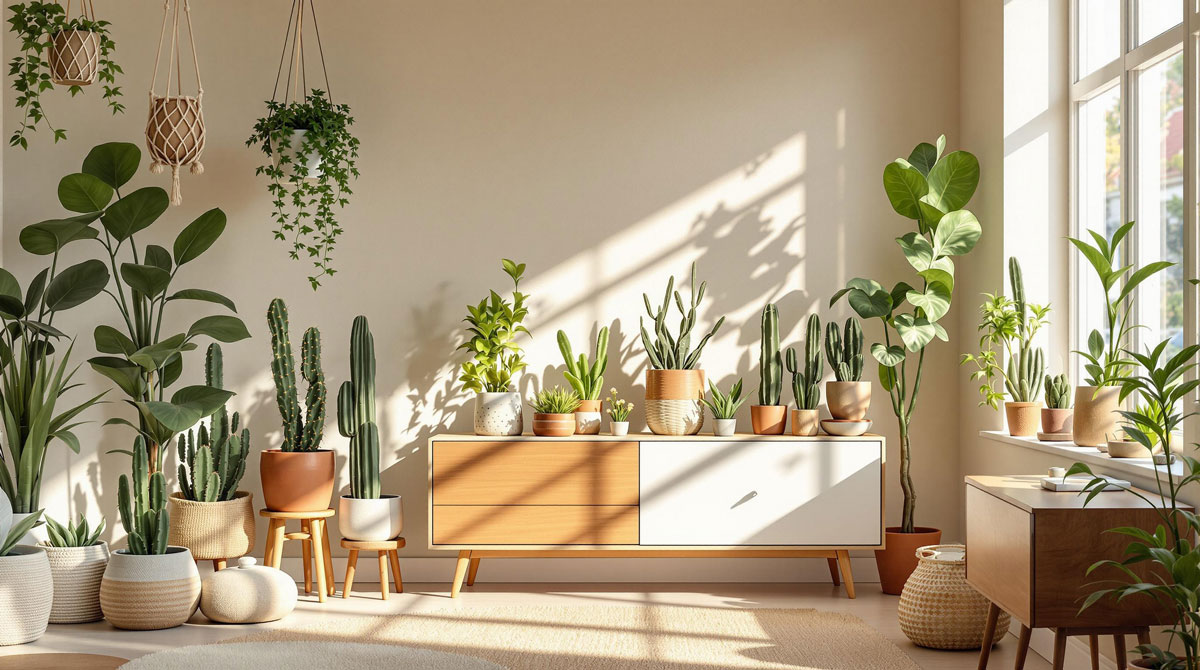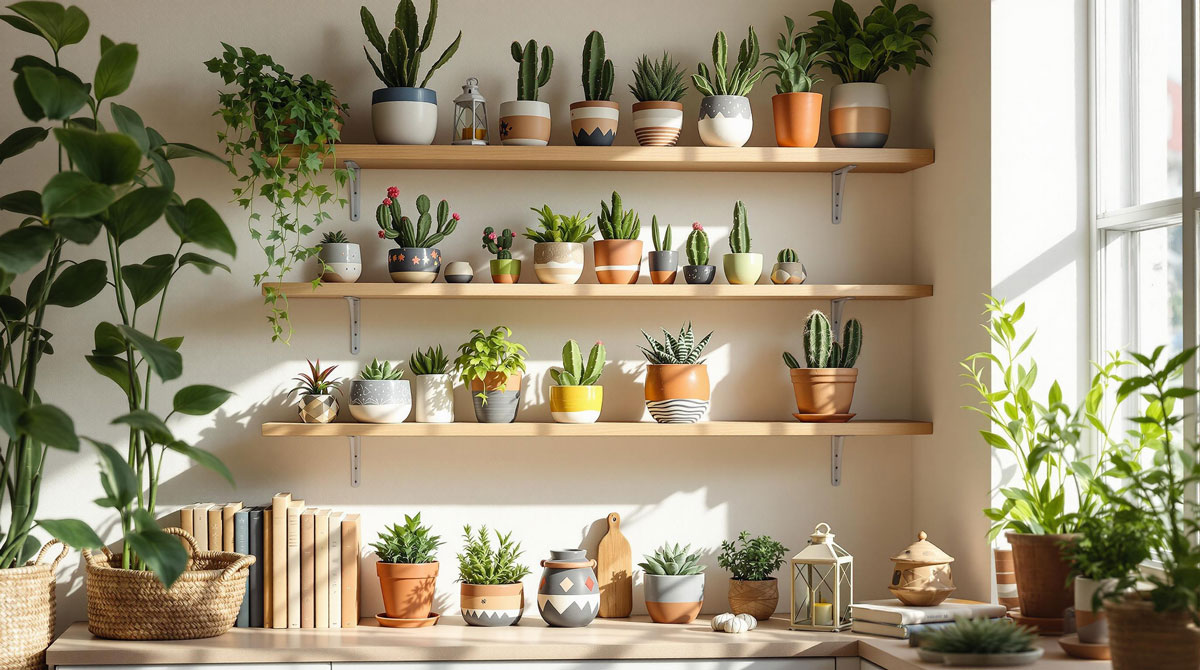Cacti are more than just desert plants—they’re some of the best companions for indoor living. These hardy, low-maintenance plants bring a touch of nature into your home while requiring minimal effort to thrive.
Whether you’re a seasoned plant enthusiast or a beginner looking for easy-care greenery, cacti are a fantastic choice for indoor spaces. In this guide, you’ll find:
- The best cactus varieties for indoors
- Step-by-step care tips for success
- Solutions for common problems like pests and overwatering
- Creative styling ideas to decorate your space
- Simple methods to propagate cacti at home
By the end, you’ll be ready to create your own mini indoor desert oasis.
Benefits of growing cacti indoors
1. Low maintenance
Cacti are famously easy to care for. They need less water than most plants and can handle neglect like champions. Perfect for people with busy schedules or those prone to forgetting to water!
2. Aesthetic appeal
Cacti come in a variety of shapes, sizes, and colors. From small desk companions to statement floor plants, they blend seamlessly with almost any home décor:
- Minimalist homes: Compact cacti like Moon Cactus.
- Bohemian vibes: Group different species together.
- Modern interiors: Tall, columnar cacti like the Mexican Fence Post.
3. Health and well-being
Having cacti indoors improves air quality and contributes to mental well-being:
- They release oxygen and absorb CO2.
- Adding greenery helps reduce stress and boost mood.
Best cacti varieties for indoors
Choosing the right cactus for your space depends on light levels, available room, and personal style. Here’s a quick breakdown of the best indoor cactus varieties:
| Cactus variety | Size | Light needs | Features |
|---|---|---|---|
| Moon cactus | Small | Indirect light | Colorful, easy to maintain |
| Bunny ears cactus | Small-Medium | Bright, indirect light | Cute, fuzzy pads; great for beginners |
| Christmas cactus | Medium | Low to moderate light | Flowers during holidays; low-maintenance |
| Old man cactus | Medium-Large | Bright, direct light | Fuzzy, unique “white hair” appearance |
| Golden barrel cactus | Medium | Bright light | Rounded, iconic shape; very hardy |
| Fairy castle cactus | Medium | Bright, indirect light | Castle-like stems; whimsical structure |
Tips for choosing the right cactus:
- Small spaces: Opt for compact varieties like Moon Cactus or Bunny Ears.
- Bright windows: Tall cacti like the Old Man Cactus or Fairy Castle thrive with lots of light.
- Shady interiors: The Christmas Cactus is ideal for low-light homes.
How to care for indoor cacti
Light requirements
Bright, indirect light is ideal. Place cacti near south- or east-facing windows. If natural light is limited, use grow lights to supplement sunlight.
Quick Tip: Rotate your cactus every few weeks to ensure even light exposure and prevent leaning.
Watering schedule
Cacti are drought-tolerant, but they do need water occasionally:
- The “soak and dry” method: Water deeply until the soil is saturated, then allow it to dry completely before watering again.
- Seasonal watering: Water more in spring and summer (growth season) and less in fall and winter (dormant season).
Signs of underwatering: Wrinkled or shriveled stems.
Signs of overwatering: Yellowing or mushy stems.
Soil and potting needs
- Use a cactus-specific soil mix with excellent drainage.
- Choose pots with drainage holes. Terracotta pots are best, as they absorb excess moisture.
Fertilizing tips
Feed your cactus during its growing season (spring and summer) with a low-nitrogen, balanced fertilizer. Avoid fertilizing during fall and winter.
Common problems with indoor cacti and how to fix them
1. Overwatering and root rot
Symptoms: Yellowing, mushy stems, or foul-smelling soil.
Solution: Remove the cactus, trim rotted roots, and repot in dry, fresh soil.
2. Pests
Common pests: Mealybugs, spider mites, and scale insects.
Solution: Dab pests with rubbing alcohol or spray the plant with diluted neem oil.
3. Lack of light
Symptoms: Stretched, pale, or “leggy” growth (etiolation).
Solution: Move your cactus to a brighter spot or use grow lights to supplement.
Creative styling ideas for indoor cacti
- Grouping cacti together: Combine various sizes and textures for a dynamic display.
- Using decorative pots: Choose colorful or minimalist designs to match your décor.
- Hanging displays: Trailing cacti like the Christmas Cactus look stunning in hanging pots.
- Terrariums: Style small cacti in glass containers with pebbles for a modern look (ensure proper drainage).
How to propagate cacti for indoor growth
- Select a healthy cutting: Use a clean knife to remove a pad or stem section.
- Let it callous: Allow the cutting to dry for 2-3 days until a callus forms.
- Plant the cutting: Insert it into a pot with well-draining soil.
- Wait before watering: After 7-10 days, lightly water to encourage root development.
Conclusion
Cacti are a perfect mix of beauty, resilience, and simplicity. Whether you’re decorating a desk, shelf, or living space, there’s a cactus for every indoor environment. By following these tips for care, styling, and propagation, you’ll enjoy the endless benefits of growing these wonderful plants indoors.
FAQs
| Question | Answer |
|---|---|
Can cactus survive without direct sunlight? |
Yes, some cacti like the Christmas cactus can tolerate low light, but most require bright, indirect sunlight to grow well. |
How often should I water an indoor cactus? |
Water only when the soil is completely dry, typically every 1-2 weeks in summer and less frequently in winter. |
Do cacti purify indoor air? |
Yes, cacti absorb CO2 and release oxygen, contributing to better air quality. |
What is the easiest indoor cactus to care for? |
Moon cactus, Bunny Ears, and Christmas Cactus are all beginner-friendly options. |
How long can an indoor cactus live? |
With proper care, indoor cacti can live for decades. Some species can last over 30 years. |

